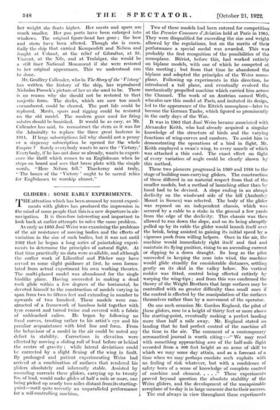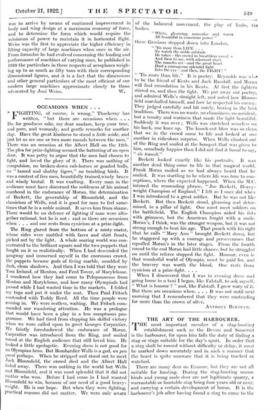GLIDERS : SOME EARLY EXPERIMENTS. T HE attention which has been
aroused by recent experi- ments with gliders has produced the impression in the mind of some people that this is a new departure in air- navigation. It is therefore interesting and important to look back at earlier attempts to solve the same problem.
As early as 1895 Jose Weiss was examining the problems of the air resistance of moving bodies and the effects of variation in the size of such bodies, but it was not until 1902 that he began a long series of painstaking experi- ments to determine the principles of natural flight. At that time practically no data were available, and although the earlier work of Lilienthal and Pilcher may have served as some slight guidance at first, he soon formu- lated from actual experiment his own working theories. The multi-planed model was abandoned for the single birdlike plane. Having succeeded in making a dead rook glide within a few degrees of the horizontal, he devoted himself to the construction of models varying in span from two to fifteen feet and extending in number to upwards of two hundred. These models were con- structed of a framework of bamboo held together with tyre cement and tarred twine and covered with a fabric of unbleached calico. He began by following no fixed curves, trusting rather to his artist's eye and his peculiar acquaintance with bird line and form. From the behaviour of a model in the air could be noted any defect in stability. Corrections in elevation were effected by moving a sliding roll of lead before or behind the centre of gravity ; while lateral deviations could be corrected by a slight flexing of the wing in fault.
By prolonged and patient experimenting Weiss had arrived at a combination of surfaces that rendered his gliders absolutely and inherently stable. Assisted by ascending currents these gliders, carrying up to twenty lbs. of lead, would make glides of half a mile or more, one being picked up nearly two miles distant from its starting. point—until quite recently an unparalleled performance for a self-controlling machine. Two of these models had been entered for competition at the Premier Concours d' Aviation held at Paris in 1903. .They were disqualified for exceeding the size and weight allowed by the regulations, but on the merits of their performance a special medal was awarded. This was probably the first recognition of the possibilities of the monoplane. Bleriot, before this, had worked entirely on biplane models, with one of which he competed at this meeting ; but from that time he abandoned the biplane and adopted the principles of the Weiss mono- plane. Following up experiments in this direction, he introduced a tail plane, and eventually evolved the mechanically propelled machine which carried him across the Channel. The work of an Austrian named Wells, who also saw this model at Paris, and imitated its design, led to the appearance of the Eitrich monoplane—later to become the German Taube, which figured so prominently in the early days of the War.
It was in 1905 that Jose Weiss became associated with Alexander Keith, who had already acquired a singular knowledge of the structure of birds and the varying functions of wing-curves and cambers. To assist him in demonstrating the operations of a bird in flight, Mr. Keith employed a swan's wing, to every muscle of which was attached a thin cord. The exact effect on flight of every variation of angle could be clearly shown by this method.
These two pioneers progressed in 1909 and 1910 to the stage of building man-carrying gliders. The construction of these differed in no material respect from that of the smaller models, but a method of launching other than by hand had to be devised. A slope ending in an abrupt declivity on the windward side of the hill (Amberley Mount in Sussex) was selected. The body of the glider was reposed on an independent chassis, which was secured by a cable to a stake in the ground a few yards from the edge of the declivity. This chassis was then allowed to run down the slope, and on its being abruptly pulled up by its cable the glider would launch itself over the brink, being assisted in gaining its initial speed by a vigorous push from willing helpers. Once in the air, the machine would immediately right itself and find and maintain its flying position, rising to an ascending current or dipping to a down draught. So long as the pilot succeeded in keeping the nose into wind, the machine would glide steadily for considerable distances, settling gently on its skid in the valley below. No vertical rudder. was fitted, control being effected entirely by warping the wing-tips ; and from this was confirmed the theory of the Wright Brothers that large surfaces may be controlled with no greater difficulty than small ones if the control is effected by the manipulation of the surfaces themselves rather than by a movement of the operator. On one such occasion Mr. Gordon England, the pilot of these gliders, rose to a height of thirty feet or more above the starting-point, eventually making a perfect landing more than half a mile away. Mr. England stated on landing that he had perfect control of the machine all the time in the air. The comment of a contemporary aeronautical journal is worth citing :—" We may read with something approaching awe of the half-mile flight recorded from a 400 feet height as an acme of skill to which we may some day attain, and as a forecast of a time when we may perhaps emulate such exploits with no feeling of risk whatever, but with a confidence of safety born of a sense of knowledge of complete control of machine and element " These experiments proved beyond question the absolute stability of the Weiss gliders, and the development of the uncapsizable aeroplane of to-day is in large measure due to their success. The end always in view throughout these experiments was to arrive by means of continued improvement in body and wing design at a maximum economy of force, and to determine the form which would require the minimum of power to maintain it in horizontal flight. Weiss was the first to appreciate the higher efficiency in lifting capacity of large machines when once in the air. From formulae he had evolved concerning the loading and performance of machines of varying sizes, he published in 1910 the particulars in these respects of aeroplanes weigh- ing up to as much as fifty tons with their corresponding dimensional figures, and it is a fact that the dimensions and other general particulars of the most efficient of our modern large machines approximate closely to those advocated by Jose Weiss.



































































 Previous page
Previous page